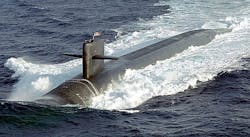Navy asks Lockheed Martin for COTS-based sonar electronics for nation's submarine fleet
WASHINGTON, 16 Dec. 2015. Lockheed Martin Corp. received another order Tuesday to provide commercial off-the-shelf (COTS) open-systems computer hardware and software to upgrade digital signal processing in the sonar systems of the U.S. Navy's submarine fleet.
Officials of the Naval Sea Systems Command in Washington announced a $13.7 million contract modification to the Lockheed Martin Mission Systems and Training segment in Manassas, Va., for Acoustics-Rapid COTS Insertion (A-RCI) and common acoustics processing development and production related to technology insertion 14 (TI-14) for the U.S. submarine fleet.
A-RCI is a sonar system that integrates and improves towed array, hull array, sphere array, and other ship sensor processing through rapid insertion of commercial-off-the-shelf-based hardware and software, such as commercial blade servers. This modification will purchase TI-14 upgrades.
For nearly two decades Lockheed Martin sonar experts have been harvesting the most advanced and most promising COTS digital signal processing (DSP) equipment -- from embedded servers, field-programmable gate arrays (FPGAs), to powerful general-purpose processors) -- to achieve the most advanced submarine sonar signal processing at the most reasonable cost.
The A-RCI program is among the most visible U.S. military acknowledgements that COTS technology delivers the most capability at the least cost for defense-related embedded digital signal processing technology.
The A-RCI program, as its name suggests, seeks to move the latest COTS DSP technology into submarine signal processing systems aboard Virginia-, Seawolf-, and Los Angeles-class fast attack submarines, as well as aboard Ohio-class ballistic-missile and cruise-missile submarines, on a regular basis to keep pace with commercial embedded computing developments.
A-RCI is an open-architecture sonar system that Navy officials intend to maintain an advantage in acoustic detection of threat submarines, using legacy sonar sensors. The program regularly refreshes central processors with COTS computer technology and software. A-RCI processors handle data from the submarine’s spherical array, hull array, wide aperture array, high-frequency arrays, and towed arrays.
An open-systems architecture makes the most of commercial processing development, and enables submarine signal processing systems to use complex algorithms that Navy-developed sonar systems such as the AN/BSY-1 and AN/BSY-2 systems cannot not use.
Using COTS technology enables onboard computing power to grow at nearly the same rate as commercial industry, and facilitates regular updates to submarine sonar-processing software and hardware with minimal disruption to submarine scheduling, Navy officials say.
On this contract modification Lockheed Martin will do the work in Manassas, Va., and Clearwater, Fla., and should be finished by September 2019. For more information contact Lockheed Martin Mission Systems and Training online at www.lockheedmartin.com/us/mst, or Naval Sea Systems Command at www.navsea.navy.mil.

John Keller | Editor
John Keller is editor-in-chief of Military & Aerospace Electronics magazine, which provides extensive coverage and analysis of enabling electronic and optoelectronic technologies in military, space, and commercial aviation applications. A member of the Military & Aerospace Electronics staff since the magazine's founding in 1989, Mr. Keller took over as chief editor in 1995.

